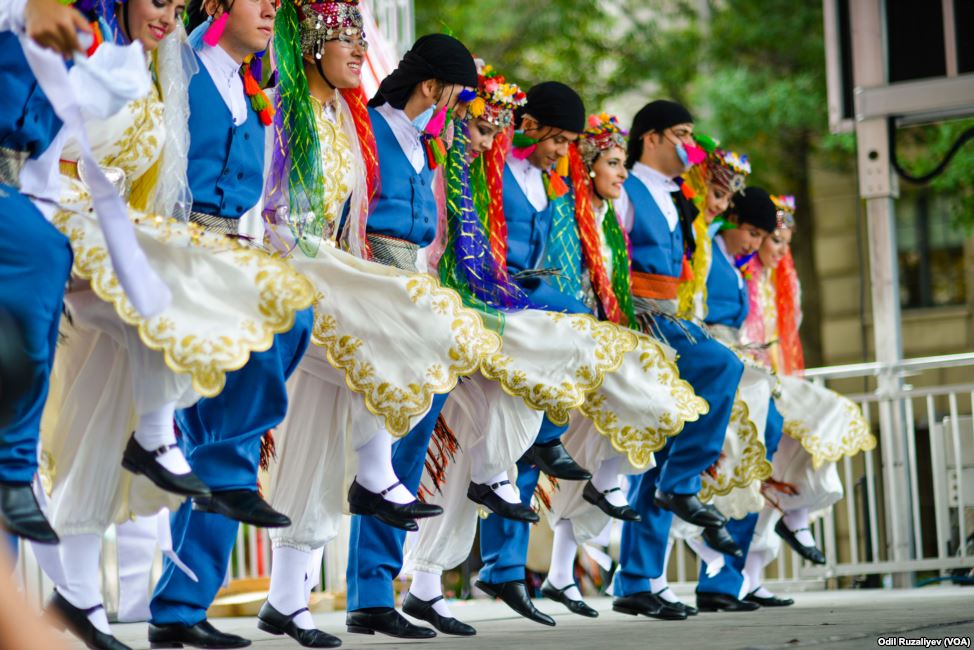|
Dance In Turkey
Turkish folk dances are the folk dances of Turkey. Facing three seas, straddling important trade routes, Turkey has a complex, sophisticated culture, reflected in the variety of its dances. The dominant dance forms are types of line dance. There are many different types of folk dances performed in various ways in Turkey. Zeybek, Teke Zortlatması in Aegean region, Bar in Erzurum province, Halay in the central, southern, eastern, and southeastern parts of the country, Hora in Thrace, Horon in the eastern Black Sea region, Spoon dances in and around Konya, and Lezginka in Kars and Ardahan are some of the best known examples of these. Types of dance Bar With their structure and formation, they are the dances performed by groups in the open. They are spread, in general, over the eastern part of Anatolia (Erzurum, Bayburt, Ağrı, Kars, Artvin and Erzincan provinces). The characteristic of their formation is that they are performed side-by-side, hand, shoulder and arm-in-arm. W ... [...More Info...] [...Related Items...] OR: [Wikipedia] [Google] [Baidu] |
Turkish Folk Dance Team
Turkish may refer to: *a Turkic language spoken by the Turks * of or about Turkey ** Turkish language *** Turkish alphabet ** Turkish people, a Turkic ethnic group and nation *** Turkish citizen, a citizen of Turkey *** Turkish communities and minorities in the former Ottoman Empire * Ottoman Empire (Ottoman Turkey), 1299–1922, previously sometimes known as the Turkish Empire ** Ottoman Turkish, the Turkish language used in the Ottoman Empire * Turkish Airlines, an airline * Turkish music (style), a musical style of European composers of the Classical music era See also * * * Turk (other) * Turki (other) * Turkic (other) * Turkey (other) * Turkiye (other) * Turkish Bath (other) * Turkish population, the number of ethnic Turkish people in the world * Culture of Turkey * History of Turkey :''See History of the Republic of Turkey for the history of the modern state.'' The history of Turkey, understood as the histo ... [...More Info...] [...Related Items...] OR: [Wikipedia] [Google] [Baidu] |
Kars
Kars (; ku, Qers; ) is a city in northeast Turkey and the capital of Kars Province. Its population is 73,836 in 2011. Kars was in the ancient region known as ''Chorzene'', (in Greek Χορζηνή) in classical historiography ( Strabo), part of Kingdom of Armenia (antiquity), in Ayrarat province, and later the capital of Bagratid Kingdom of Armenia in 929–961. Currently, the mayor of Kars is Türker Öksüz. The city had an Armenian ethnic majority until it was conquered by Turkish nationalist forces in late 1920. Etymology The city's name may be derived from the Armenian word հարս (''hars''), meaning "bride". Another hypothesis has it that the name derives from the Georgian word "the gate. History Medieval period Little is known of the early history of Kars beyond the fact that, during medieval times, it had its own dynasty of Armenian rulers and was the capital of a region known as Vanand. Medieval Armenian historians referred to the city by a variety of n ... [...More Info...] [...Related Items...] OR: [Wikipedia] [Google] [Baidu] |
Kaval
The kaval is a chromatic end-blown flute traditionally played throughout the Balkans (in Albania, Romania, Bulgaria, Southern Serbia, Kosovo, North Macedonia, Northern Greece, and elsewhere) and Anatolia (including Turkey and Armenia). The kaval is primarily associated with mountain shepherds. Unlike the transverse flute, the kaval is fully open at both ends, and is played by blowing on the sharpened edge of one end. The kaval has eight playing holes (seven in front and one in the back for the thumb) and usually four more unfingered intonation holes near the bottom of the kaval. As a wooden rim-blown flute, kaval is similar to the '' kawala'' of the Arab world and '' ney'' of the Middle East. Construction While typically made of wood ( cornel cherry, apricot, plum, boxwood, mountain ash, etc.), kavals are also made from water buffalo horn, ''Arundo donax'' 1753 (Persian reed), metal and plastic. A kaval made without joints is usually mounted on a wooden holder, which ... [...More Info...] [...Related Items...] OR: [Wikipedia] [Google] [Baidu] |
Aksak
In Ottoman musical theory, ''aksak'' is a rhythmic system in which pieces or sequences, executed in a fast tempo, are based on the uninterrupted reiteration of a matrix, which results from the juxtaposition of rhythmic cells based on the alternation of binary and ternary quantities, as in , , , etc. The name literally means "limping", "stumbling", or "slumping", and has been borrowed by Western ethnomusicologists to refer generally to irregular, or additive meters. In Turkish folk music, these metres occur mainly in vocal and instrumental dance music, though they are found also in some folksongs. Strictly speaking, in Turkish music theory the term refers only to the grouping of nine pulses into a pattern of . Some examples are shown below. In jazz The ''aksak'' rhythm is prominently featured in the jazz standard Jazz standards are musical compositions that are an important part of the musical repertoire of jazz musicians, in that they are widely known, performed, and r ... [...More Info...] [...Related Items...] OR: [Wikipedia] [Google] [Baidu] |

